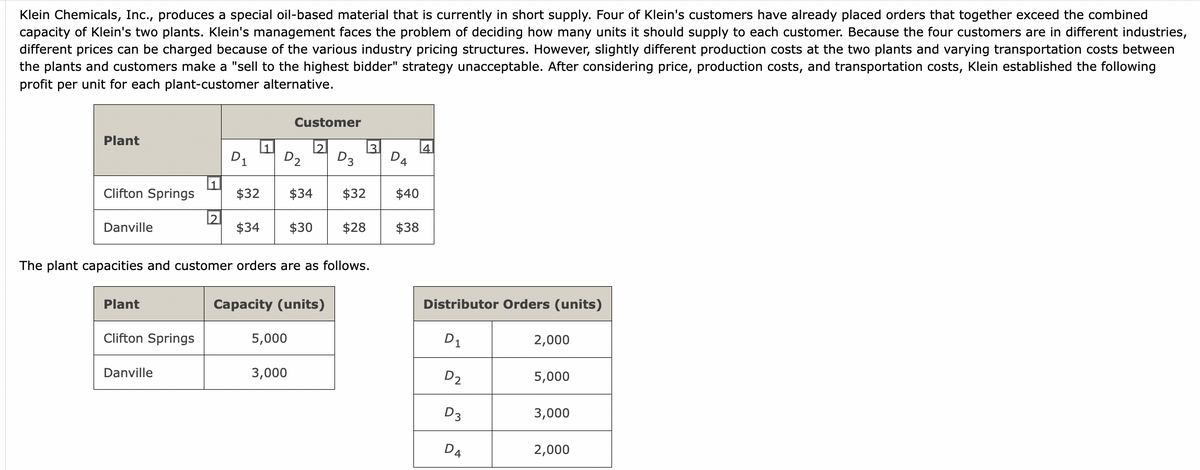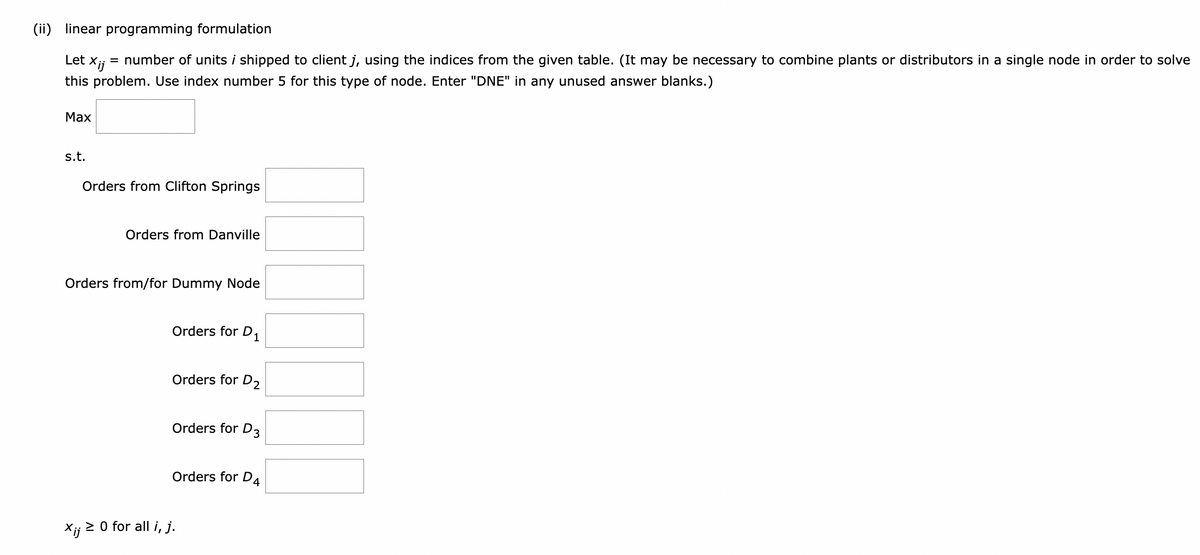(ii) linear programming formulation Let x₁ = number of units i shipped to client j, using the indices from the given table. (It may be necessary to combine plants or distributors in a single node in order to this problem. Use index number 5 for this type of node. Enter "DNE" in any unused answer blanks.) Max s.t. Orders from Clifton Springs
(ii) linear programming formulation Let x₁ = number of units i shipped to client j, using the indices from the given table. (It may be necessary to combine plants or distributors in a single node in order to this problem. Use index number 5 for this type of node. Enter "DNE" in any unused answer blanks.) Max s.t. Orders from Clifton Springs
Practical Management Science
6th Edition
ISBN:9781337406659
Author:WINSTON, Wayne L.
Publisher:WINSTON, Wayne L.
Chapter7: Nonlinear Optimization Models
Section7.3: Pricing Models
Problem 14P: PRICING SUITS AT SULLIVANS Sullivans is a retailer of upscale mens clothing. Suits cost Sullivans...
Related questions
Question

Transcribed Image Text:Klein Chemicals, Inc., produces a special oil-based material that is currently in short supply. Four of Klein's customers have already placed orders that together exceed the combined
capacity of Klein's two plants. Klein's management faces the problem of deciding how many units it should supply to each customer. Because the four customers are in different industries,
different prices can be charged because of the various industry pricing structures. However, slightly different production costs at the two plants and varying transportation costs between
the plants and customers make a "sell to the highest bidder" strategy unacceptable. After considering price, production costs, and transportation costs, Klein established the following
profit per unit for each plant-customer alternative.
Plant
Clifton Springs
Danville
Plant
Clifton Springs
2
Danville
D₁
D3
D₂
$32 $34 $32 $40
$38
$34 $30 $28
The plant capacities and customer orders are as follows.
Customer
Capacity (units)
5,000
3,000
3
4
4
Distributor Orders (units)
D1
D₂
D3
D4
2,000
5,000
3,000
2,000

Transcribed Image Text:(ii) linear programming formulation
Let
Xij
; = number of units i shipped to client j, using the indices from the given table. (It may be necessary to combine plants or distributors in a single node in order to solve
this problem. Use index number 5 for this type of node. Enter "DNE" in any unused answer blanks.)
Max
s.t.
Orders from Clifton Springs
Orders from Danville
Orders from/for Dummy Node
Orders for D₁
Orders for D2
Orders for D3
Orders for D4
Xij ≥ 0 for all i, j.
Expert Solution
This question has been solved!
Explore an expertly crafted, step-by-step solution for a thorough understanding of key concepts.
This is a popular solution!
Trending now
This is a popular solution!
Step by step
Solved in 2 steps

Recommended textbooks for you

Practical Management Science
Operations Management
ISBN:
9781337406659
Author:
WINSTON, Wayne L.
Publisher:
Cengage,

Practical Management Science
Operations Management
ISBN:
9781337406659
Author:
WINSTON, Wayne L.
Publisher:
Cengage,